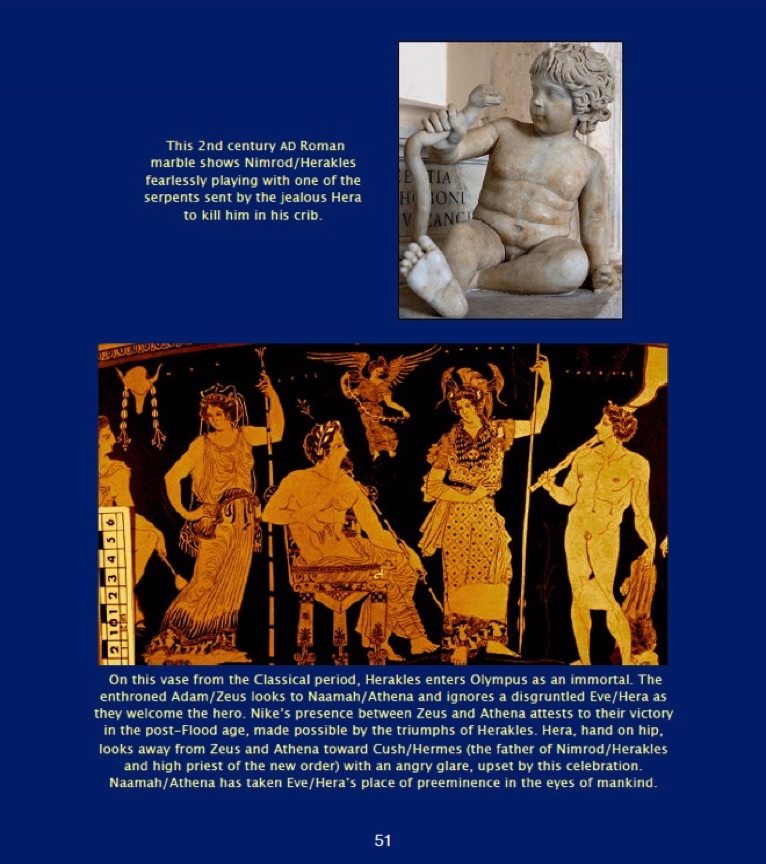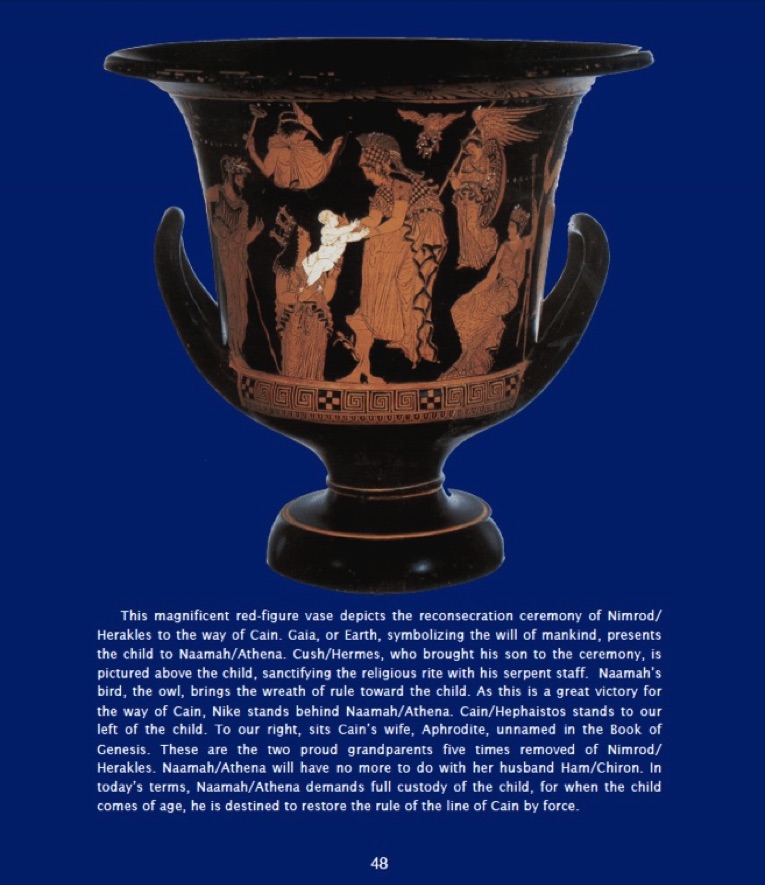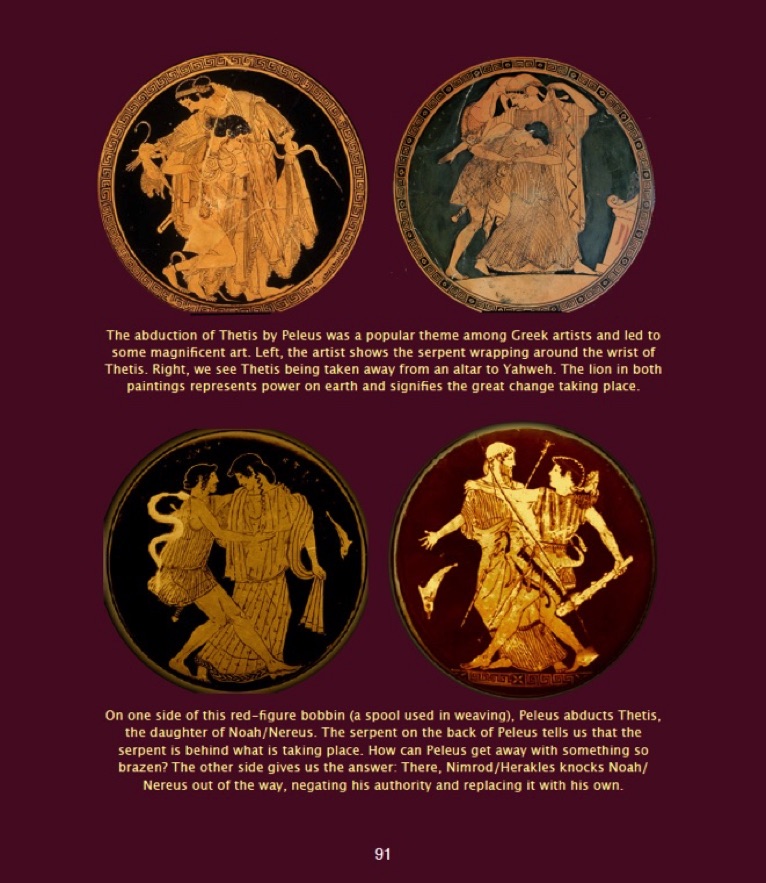SAMPLE PAGES
THE MAGNIFICENCE OF ANCIENT GREEK RELIGIOUS TEMPLE AND VASE ART
On Sale Now from www.Solving Light.com $24.95 + FREE SHIPPING
On Amazon Paperback ($29) and Kindle
MORE THAN 160 FULL-COLOR IMAGES FROM THE ANCIENT WORLD
To order by check or money order, contact:





The east pediment of the Parthenon celebrates the deathlessness or immortality of Naamah/Athena. She stands next to Zeus in the center, as Nike (in yellow) representing her great post-Flood victory, faces the three Fates: Clotho (E) who spins the thread of life, Lachesis (F) who measures it, and Atropos (G) who cuts it. Atropos means unturnable: she cannot be stopped from cutting the thread of life when the time has come. And yet Atropos, the unturnable one, is magnificently sculpted as turning back when confronted by Athena's Nike. Naamah/Athena is the immortal one who can turn back fate.
The three Fates: E, F, and G from the east pediment of the Parthenon, now in the British Museum. Reconstructions by Holmes Bryant
This magnificent red-figure vase, above, depicts the reconsecration ceremony of Nimrod/Herakles to the way of Cain. Gaia, or Earth, symbolizing the will of mankind, presents the child to Naamah/Athena. Cush/Hermes, who brought his son to the ceremony, is pictured above the child, sanctifying the religious rite with his serpent staff. Naamah’s bird, the owl, brings the wreath of rule toward the child. As this is a great victory for the way of Cain, Nike stands behind Naamah/Athena.
Cain/Hephaistos stands to our left of the child. To our right, sits Cain’s wife, Aphrodite, unnamed in the Book of Genesis. These are the two proud grandparents of Nimrod/Herakles five times removed. Naamah/Athena will have no more to do with her husband Ham/Chiron. In today’s terms, Naamah/Athena demands full custody of the child, for when the child comes of age, he is destined to restore the rule of the line of Cain by force.
This 2nd century AD Roman marble shows Nimrod/Herakles fearlessly playing with one of the serpents sent by the jealous Hera to kill him in his crib
On this vase from the Classical period, Herakles enters Olympus as an immortal. The enthroned Adam/Zeus looks to Naamah/Athena and ignores a disgruntled Eve/Hera as they welcome the hero. Nike’s presence between Zeus and Athena attests to their victory in the post-Flood age, made possible by the triumphs of Herakles. Hera, hand on hip, looks away from Zeus and Hera toward Cush/Hermes (the father of Nimrod/Herakles and high priest of the new order) with an angry glare, upset by this celebration. Athena has taken Hera’s place of preeminence in the eyes of mankind.
Nimrod/Herakles is not some odd, mysteriously appearing character dreamed up by Greek poets and artists: He has a father (Cush/Hermes), a grandmother (Naamah/Athena), and a great-grandfather (Lamech/Atlas) who ruled prior to the Flood.
On the vase-scene above, Lamech/Atlas sits enthroned as king next to Gaia, or Earth, signifying that he ruled the Cainite world prior to the Flood. The seated Hesperid and the serpent-entwined apple tree to our right signify that Lamech ruled in accord with the serpent’s so-called proffered wisdom—God denied or ignored, and mankind exalted as the measure of all things.
From our left, we see Cush/Hermes and Nimrod/Herakles approaching the throne of Lamech/Atlas. Herakles/Nimrod has advanced to the throne in front of his father, Cush/Hermes, because he has been groomed by Naamah/Athena to become the rightful ruling heir of Lamech in the post-Flood world. Nimrod/Herakles is Lamech’s great-grandson through Lamech’s daughter, Naamah/Athena. This vase-scene is about restoring the ruling family of the line of Cain after the Flood.
Nimrod/Herakles shows off his lion skin boasting of his great prowess, and carries his club as if to say “I am determined to restore our family as rulers of mankind through force.”
On one side of this red-figure bobbin (a spool used in weaving), Peleus abducts Thetis, the daughter of Noah/Nereus. The serpent on the back of Peleus tells us that the serpent is behind what is taking place. How can Peleus get away with something so brazen? The other side gives us the answer: There, Nimrod/Herakles forces Noah/Nereus out of the way, negating his authority and replacing it with his own.
The abduction of Thetis by Peleus was a popular theme among Greek artists and led to some magnificent art. On the plate, left, the artist shows the serpent wrapping around the wrist of Thetis. Right, we see Thetis being taken from an altar to Yahweh. The lion in both paintings represents power on earth and signifies the great change taking place.
